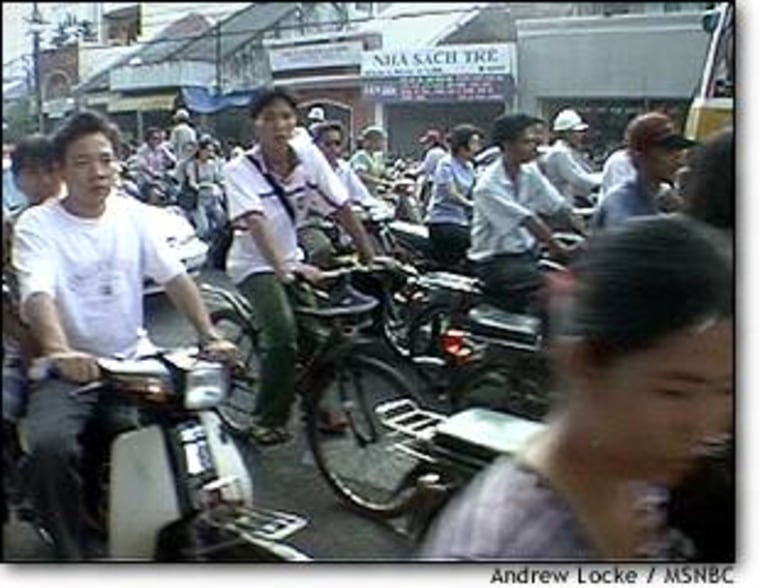In front of the new American consulate here in the former South Vietnamese capital, Mrs. Lam waits patiently for tourists. But few come these days. Ever since the former U.S. embassy was demolished in 1998, her postcard business has declined. Her business idea — selling pictures of the old building — has failed to take off. The fact is, the city is leaving the war behind, and is reclaiming its legacy as the commercial hub of Vietnam.
The U.S. embassy was long a destination for war buffs because it was here, in 1975, that a handful of U.S. Embassy Marines staged one of the most dramatic airlifts in history.
It was April 29th, and the United States had pulled out all but a handful of troops, opening the way for North Vietnamese regulars to move south. Now all that was left was for them to occupy Saigon.
For thousands of South Vietnamese who had been part of the American war effort, total panic set in as they looked for a way to escape. Crowds of terrified people pressed up against the embassy gates, hoping to join the exodus — and many failed.
As North Vietnamese rocketed the airport, a final reminder that it was time to leave, the U.S. turned to helicopters. For 18 hours … a fleet of 70 marine choppers shuttled people between the city and aircraft carriers offshore. In that time, they lifted more than 1,000 Americans, and 6,000 Vietnamese from the fray.
Then, seemingly overnight, after decades of colonization and civil war, Vietnam became one country. Saigon became Ho Chi Minh City, renamed to honor the man who set Vietnam’s independence movement in motion.
What followed were years of hardship for Vietnam — and a harsh turn for the city, which had been a boomtown during the war. With Saigon’s fall, families were divided, businesses taken over by the state. Poverty deepened — in part a result of a U.S.-led trade embargo that lasted until 1993.
But in the last decade, as Vietnam has struggled to reform its flagging economy, and open up to the world, Saigon has rebounded fastest, emerging once again Vietnam’s center of business and hustle.
Now, migrants come from all over the country to seek a fortune in the city. Here, per capita income is more than $1,000 a year, about three times that of the country as a whole. And last year, United States opened a new consulate at the site of the old embassy in Saigon — a landmark moment for both sides.
Five years of renewed ties between the two countries have been far from perfect — outstanding issues include Washington’s ongoing search for soldiers still considered Missing in Action, and criticism of Hanoi’s human rights record. Vietnam and the United States still haven’t signed a deal to normalize trade, though negotiations have been creeping in that direction since 1996.
Generation gap
School children make class trips to war museums that exhibit U.S. fighter jets and pictures of wartime atrocities. But in Vietnam, there’s a major generation gap when it comes to talking about the war.
“For the younger generation, they don’t really care. They have to come to look at all the pictures of American atrocities,” says Ron Moreau, a long-time Newsweek correspondent in the region. But they just want to get ahead.”
For the older generation, its quite different. “I think that for the wartime generation, people are still living that, because the losses were so heavy,” says Moreau, a fluent Vietnamese speaker. “All you have do is ask them one question…”
Gradually, some of the people who left South Vietnam as refugees are now coming back. Some return to retire in their homeland. One young man named Chinh, who emigrated to the United States in 1993, returned to Saigon from Los Angeles in late March to pay a visit to relatives. He said the Saigon relatives made so much money in real estate that they gave him the seed money to start a hair and nails salon in the L.A. area.
Post-war population
So, while there is still a profit to be made selling fake U.S. dog tags and Zippo cigarette lighters to Western travelers, the old wartime landmarks and journalist haunts are gradually disappearing.
The Rex Hotel, once home to the daily U.S. military attaché’s press briefing — dubbed the “Five O’Clock Follies” — still exists, but it’s a drab relic against the city’s glittery new hotels, discos and cyber cafes.
Vietnam’s younger generation seems firmly fixed on the present and the future, rather than a war that cost this country several million lives. And in a country where 65 percent of the population was born in the last 25 years, that may be the only trend that truly heals the agony of war.
Battle Scars is a joint production of Newsweek and MSNBC, with MSNBC’s Andrew Locke producing the video images.
